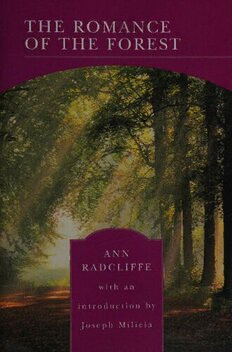
The Romance of the Forest; Interspersed with Some Pieces of Poetry PDF
Preview The Romance of the Forest; Interspersed with Some Pieces of Poetry
THE ROMANCE OF THE FOREST oun RADCUIFEE with an introduction by Joseph Miulicia | - hoe THE ROMANCE OF THE FOREST ov UNT 40 ROeWyA MOM ane 4 E. ; / 4 Der . 5 ' THE ROMANCE OF THE FOREST Interspersed with Some Pieces of Poetry Ann Radcliffe Introduction by Joseph Milicia, Ph.D. BARNES & NOBLE BooKs NEW YOR K Introduction and Suggested Reading Copyright © 2004 by Barnes & Noble Books Originally published in 1791 This edition published by Barnes & Noble Publishing, Inc. All rights reserved. No part of this book may be used or reproduced in any manner whatsoever without written permission of the Publisher. Cover Design by Pronto Design, Inc. 2004 Barnes & Noble Publishing, Inc. ISBN 0-7607-5753-4 Printed and bound in the United States of America 13579108642 CONTENTS INTRODUCTION vil VOLUME I CHAPTER I 3 CHAPTER II 18 CHAPTER III 38 CHAPTER IV 50 CHAPTER V 66 CHAPTER VI 94 CHAPTER VII 107 VOLUME II CHAPTER VIII P29 CHAPTER IX 141 CHAPTER X 151 CHAPTER XI 167 CHAPTER XII 188 217 CHAPTER XIII 224 CHAPTER XIV VOLUME III 247 CHAPTER XV CHAPTER XVI 264 CHAPTER XVII 283 297 CHAPTER XVIII CHAPTER XIX 321 CHAPTER XX 336 CHAPTER XXI 3.46 CHAPTER XXII 363 CHAPTER XXIII 367 378 CHAPTER XXIV CHAPTER XXV 385 392 CHAPTER XXVI SUGGESTED READING 399 VI INTRODUCTION ALTHOUGH Ann Radcliffe did not invent the Gothic novel, she was one of its most important practitioners and established a classic pattern for what we still call Gothic fiction. The Mysteries of Udolpho, the fourth of her five novels, is most commonly cited as her mas- terwork, but her third, The Romance of the Forest, was the first to bring her great fame and remains memorable for its intense evoca- tion of a world drenched in both horror and natural splendor, beset with abductions and imprisonments and centered upon a frequently terrified but still resourceful and determined heroine. Ann Ward, an only child, was born in 1764, in London, to mod- erately respectable parents with Unitarian connections, her father a haberdasher; she was still a child when her parents moved to Bath to manage a Wedgwood showroom. At twenty-three she married William Radcliffe, publisher of the English Chronicle. Encouraged by her husband to write, Mrs. Radcliffe (as she became known to generations of readers) published her first and shortest novel, The Castles of Athlin and Dunbayne, in 1789, anony- mously and to little acclaim. A year later, A Sicilian Romance received some favorable notices, but it was her third novel, The Romance of the Forest, in 1791, that quickly became a huge success, encouraging her to add her name to the title page for the second edition. The Mysteries of Udolpho (1794) was even more a sensation with the public, making her the best-selling English writer of the 1790s. Success permitted travel to the sort of romantic places her heroines would have effused upon: a journey up the castled Rhine ‘ VII INTRODUCTION to Switzerland, followed by a tour of England’s Lake District, soon to be immortalized in the verse of Wordsworth and Coleridge. She published a travel journal the next year, and her fifth novel, The Italian, in 1797. At the height of her fame she ceased to pub- lish, though she lived until 1823. Speculation has long been that she recoiled from the publicity that came with celebrity —not least the printed gossip that she had gone insane and died of “the hor- rors” as if her mind had overheated from her Gothic imagination. (In fact, she died of complications from asthma.) Though praised in her lifetime by Walter Scott and many others—she was even compared to Shakespeare, and not unfavorably —her reputation suffered greatly as Gothic fiction, or more precisely, the sort of Gothic she practiced, went out of vogue in the 1820s. Still, she was a significant influence on Dickens and Thackeray (as she had been on Scott and most of the Romantic poets), and her reputation remained high in France. Today, with renewed popular and schol- arly interest in Gothic fiction, she is recognized as one of the most important novelists after Henry Fielding and before Jane Austen, even if the critical establishment does not place her on their level. It is generally acknowledged that Horace Walpole’s 1765 The Castle of Otranto was the first Gothic novel (actually a novella), and that Clara Reeve’s The Old English Baron (1777) was the next important work. (Both were subtitled A Gothic Tale.) But The Romance of the Forest and the two novels to follow set a new standard. “Gothic,” originally a derogatory word referring to a “barbaric” Medieval Europe (the derivation was from those tribes of Goths who helped bring down the Roman Empire), gradually became a more neutral term, settling upon a style of architecture. As eighteenth-century historical interests shifted from the Roman Empire to the Middle Ages, as tastes turned from the sharp wit and satire of Enlightenment England to the teary Sentimental novel of Samuel Richardson and others, and from gentle pastoral land- scapes to wilder Alpine scenery, a new kind of fiction combining sentiment with more intense emotions of fright began to prevail. The Gothic tale typically had a medieval setting (though Radcliffe’s VIII
